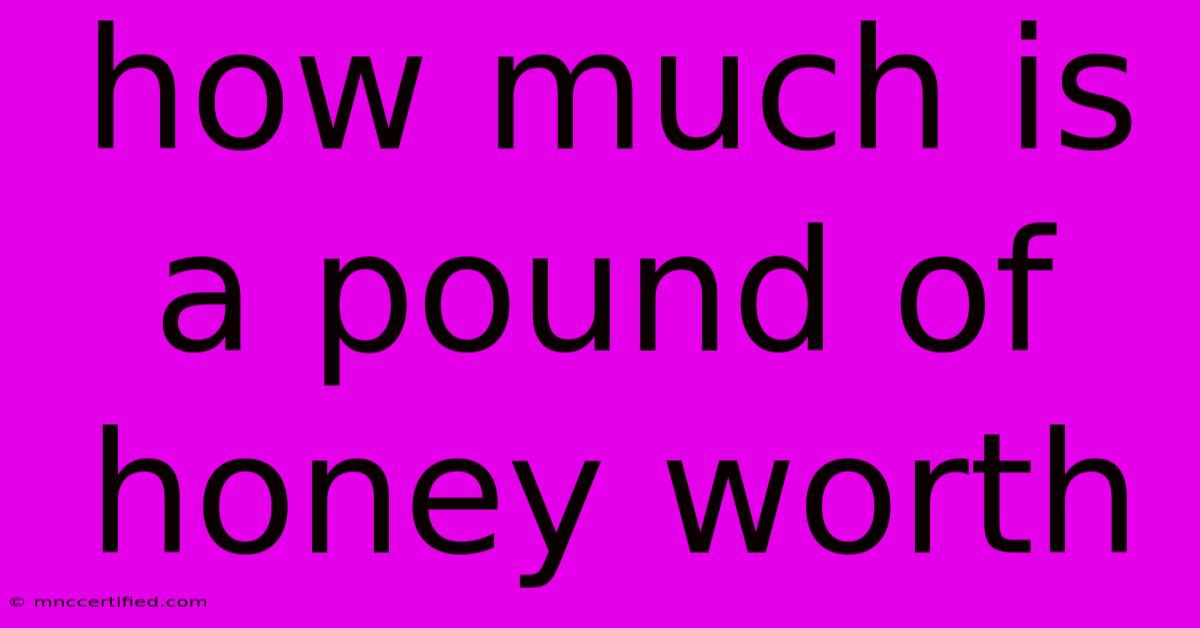How Much Is A Pound Of Honey Worth

Table of Contents
How Much is a Pound of Honey Worth? A Comprehensive Guide
Honey, a sweet golden treasure, holds more value than just its delicious taste. Its worth fluctuates based on several factors, making a simple answer to "how much is a pound of honey worth?" impossible. This comprehensive guide will delve into the various aspects influencing honey's price per pound, helping you understand its value better whether you're a producer, consumer, or simply curious.
Factors Determining the Price of Honey per Pound
The price of a pound of honey isn't fixed; it's a dynamic value affected by several key elements:
1. Type of Honey: A World of Flavors and Prices
Different honey varieties command different prices. Rare and exotic honeys, like Manuka honey from New Zealand (renowned for its unique medicinal properties), can fetch significantly higher prices per pound than common varieties like clover or alfalfa honey. The unique floral source, geographical origin, and specific properties all contribute to the price difference. For example, wildflower honey, with its complex blend of floral sources, usually commands a higher price than honey from a single, abundant source.
2. Production Methods: From Backyard to Commercial
The scale and method of honey production impact the price. Small-batch, artisanal honey, often produced by local beekeepers using sustainable practices, tends to be more expensive than mass-produced honey. This is because of higher labor costs, smaller yields, and the premium placed on quality and traceability. Organic honey, certified by relevant organizations, also commands a higher price due to its adherence to strict regulations and sustainable beekeeping methods.
3. Location and Seasonality: Geographical Influences
Geographical location and the season significantly influence honey prices. Regional variations in climate, floral diversity, and beekeeping practices affect both the yield and quality of honey. A poor honey harvest due to adverse weather conditions can lead to higher prices. Seasonal availability also plays a role; certain honeys might be more expensive during periods of limited supply.
4. Processing and Packaging: Adding Value
The processing and packaging of honey contribute to its final price. Raw honey, minimally processed and unfiltered, often costs more than processed honey, which undergoes filtration and pasteurization. The type of packaging – from simple jars to sophisticated containers – also impacts the price.
Where to Find the Best Value for Your Honey Purchase
Now that you understand the factors affecting honey prices, let's discuss where to find the best value:
- Local Farmers' Markets and Beekeepers: These are excellent places to find high-quality, locally produced honey at potentially competitive prices. You can often speak directly to the producer, learning about their methods and the unique characteristics of their honey.
- Specialty Food Stores: These stores frequently carry a wider variety of honey types, including exotic and artisanal honeys. While prices may be higher, you gain access to unique flavors and potentially higher quality.
- Online Retailers: Online platforms offer a vast selection of honeys from various regions. However, be cautious and research the sellers carefully to ensure quality and authenticity. Read reviews and look for certifications to verify claims about the honey's origin and production methods.
Conclusion: More Than Just Sweetness
The price of a pound of honey is far from a simple figure. It's a reflection of the intricate relationship between beekeepers, nature, and consumer demand. By understanding the influencing factors – honey type, production methods, location, and processing – you can make informed choices when purchasing honey, appreciating its true value beyond its delightful sweetness. Remember to support local beekeepers and sustainable practices whenever possible!

Thank you for visiting our website wich cover about How Much Is A Pound Of Honey Worth. We hope the information provided has been useful to you. Feel free to contact us if you have any questions or need further assistance. See you next time and dont miss to bookmark.
Featured Posts
-
Cynthia Erivo On Wicked Ballroom Dance
Nov 15, 2024
-
Venezuela Holds Brazil To A Draw At Home
Nov 15, 2024
-
How To Print Your Own Trading Cards
Nov 15, 2024
-
How To Watch Eagles Vs Commanders
Nov 15, 2024
-
What Is Personal Recognizance Bond
Nov 15, 2024